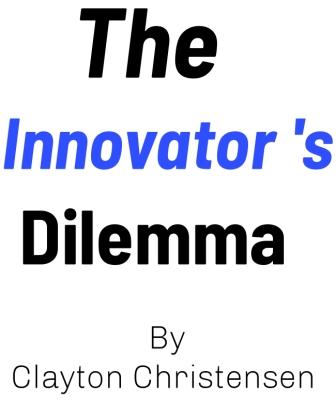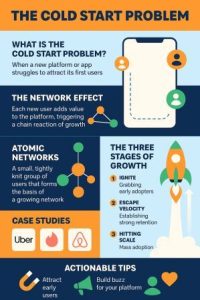The Cold Start Problem Summary

Big platforms don’t start big — they begin with a small, active group of users. If you can get that little circle working, you can build from there.
The Cold Start Problem Summary
Ever wondered how apps like WhatsApp, Uber, or Instagram went from nobody using them to everybody talking about them?
You’re not alone — it’s one of the biggest mysteries for anyone starting something new. In this The Cold Start Problem summary, you’ll learn the secret behind their explosive growth — and how you can apply the same principles to your own idea, business, or community.
We’ve only scratched the surface here — the full book is packed with powerful stories, real-life case studies, and deeper strategies.
If you’re serious about building something people can’t ignore, this book is a must-have on your shelf.
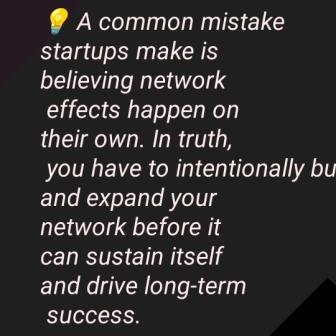
Why We Recommend this Book
The Cold Start Problem is highly recommended because it breaks down how successful products grow from zero users to global giants using network effects, making it a must-read for anyone building or promoting a digital product or community.
It has influenced startup founders, growth marketers, and product managers at companies like Airbnb, Uber, and LinkedIn, who use its principles to scale platforms from scratch.
Questions to ask yourself before reading The Cold Start Problem Summary
- What am I trying to build or grow?
Are you working on an app, platform, marketplace, or community that needs users to interact with one another? If not, does your business benefit from network effects at all? - Do I understand what “network effects” are?
Am I familiar with how value increases as more users join a product? Am I facing growth problems or struggling to attract initial users?
Have I launched something that isn’t gaining traction?Do I need strategies to spark engagement from zero?
- Who is my target audience, and how do they connect with each other?
Are there natural clusters or communities where my product could grow? Have I studied how other tech companies grew?
Am I curious to learn from case studies of companies like Uber, Airbnb, Slack, or Tinder?Do I want to apply their principles to my own project?
- Am I ready to commit long-term to building a community or product ecosystem?
Do I understand that network effects take time, iteration, and careful nurturing? - What stage is my business or product in?
Am I pre-launch, just starting, or trying to scale an existing user base?
The Cold Start Problem
Introduction
In The Cold Start Problem, Andrew Chen (a partner at Andreessen Horowitz and former growth expert at Uber) takes us behind the scenes of today’s most successful tech companies to reveal how they overcame the hardest challenge every product faces: getting people to care when nobody else is using it yet.
Using real-life examples from companies like Airbnb, Dropbox, and Tinder, Andrew explains how to build what’s called network effects — when your product becomes more valuable as more people use it.
He breaks this down into five clear stages: the Cold Start Phase, the Tipping Point, the Escape Velocity, the Ceiling, and the Moat.
The book is packed with practical lessons on launching small, scaling fast, and sustaining long-term growth — even if you’re starting from zero.
Whether you’re building an app, starting a business, or growing a community, this book gives you a blueprint to succeed.
It’s smart, engaging, and written in a way that even non-techies can understand.
Honestly, this summary only scratches the surface. If you’re serious about growth, The Cold Start Problem is a must-buy.
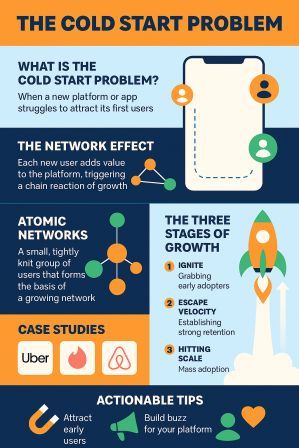
Click on the tabs below to read The Cold Start Problem Summary
The Cold Start Problem by Andrew Chen explains how startups can overcome early-stage growth challenges, harness network effects, and scale successfully by building a strong initial user base, reaching a tipping point, and sustaining long-term momentum
Who Should Read This Book?
- Startup founders who need to overcome early-stage struggles.
- Product managers and marketers looking to drive viral growth.
- Investors seeking high-growth businesses with strong network effects.
- Engineers and developers building scalable digital platforms.
- Business students and academics studying digital markets.
Why read this book?(Key Benefits)
- Avoid common startup pitfalls when launching a new product.
- Design features that encourage viral adoption and user retention.
- Understand what makes networks fail and how to prevent collapse.
- Invest smarter by identifying startups with the strongest growth potential.
- Apply proven strategies from Uber, Airbnb, Slack, Tinder, and other giants.
Here is The Cold Startup Problem Summary by Chapter:
Imagine you built this amazing new app—a platform where people can rent bicycles from each other. It’s sleek. It works. You’re proud. You open it up to the public…
…And no one uses it.
Why? Because no one else is using it.
That’s the Cold Start Problem—when the value of your product depends on people being there, but no one wants to join because, well… no one is there yet.
What Exactly Is the Cold Start Problem?
In simple terms, it’s the chicken-and-egg dilemma for startups and tech products that depend on users interacting with other users—also called networked products.
Apps like:
- Uber (needs riders and drivers),
- Instagram (needs creators and followers),
- Airbnb (needs hosts and travelers),
- WhatsApp (useless if none of your friends are on it)…
They all face the same issue at launch: how do you get the first set of users to join and stay, when the value only kicks in once others are there too?
Real-World Example: Facebook at Harvard
One of the clearest examples Andrew Chen gives is Facebook. When it launched in 2004, Mark Zuckerberg didn’t open it up to the whole world. Nope. He started with just one college—Harvard.
Why? Because launching small allowed him to:
- Fill the platform with people who already knew each other.
- Create instant value (you could stalk your crush!).
- Build buzz and social pressure to join (“Everyone at Harvard is on it—why aren’t you?”).
This tight, exclusive circle created what Chen calls an “Atomic Network”—a small, self-sustaining group of users that made the product feel alive right from the start.
What’s an Atomic Network?
Think of an atomic network like a starter fire. It’s the first, dense, interconnected user group where value is immediate, even if the total user base is small.
If you’re launching a food delivery app, maybe your atomic network is one neighborhood or a single college campus. For Slack, their atomic networks were small teams within companies. Each team had enough internal chatter to make Slack useful.
From there, these networks can spread—but first, they need to catch fire in one place.
Why? Launching to Everyone Doesn’t Work
Chen warns against the temptation of a big splash launch. Imagine launching your dating app nationwide from day one. You have 10 users in New York, 5 in Lagos, and 3 in London. No one can match. No one gets value. Everyone leaves. You die.
This is what happened to tons of early startups. They confused availability with traction.
Key Lesson: Focus on Depth, Not Breadth
If you’re starting something new that depends on users interacting, don’t try to scale too fast.
Instead:
- Start small (a niche, a city, a school, even a building).
- Create high density (people actually bump into each other on your app).
- Make value show up immediately.
Example: Tinder’s Frat Party Launch Strategy
Tinder didn’t just appear in app stores and wait. The team went to college frat houses and sororities, gave a pitch, and got them to download the app.
Then they threw parties where the only way to get in was to show the app on your phone. Boom—first atomic networks.
When students showed up and saw everyone was on it, they stayed.
You can have the best tech in the world, but if no one’s around to use it with you, it’s a ghost town. The Cold Start Problem is about getting the right first users and helping them connect so value is created early.
Don’t try to be everywhere. Be somewhere—and make that place magical.
Chapter 2: Network Effects — The Key to Overcoming Early-Stage Challenges
So, you’ve solved the Cold Start Problem—you got your first users in, and they’re getting value. Awesome. Now what?
Now you need to grow… and not just grow, but grow in a way that gets easier and more powerful as more people join.
That’s where Network Effects come in.
What Are Network Effects?
Network effects happen when a product or service gets more valuable as more people use it.
Example:
You’re the first person on WhatsApp. It’s useless.
Two people? You can chat.
Ten people? You have a group chat.
A million? Everyone’s there, and now you can’t afford to not be there.
The more, the better.
Key Insight from the Chapter:
Network effects aren’t just about growth—they’re about making your product better with every new user.
Think of it like compounding interest in a savings account. Except here, it’s value compounding, not just money.
Types of Network Effects
Andrew Chen breaks down different types of network effects so you understand which one your product might have:
1. Direct Network Effects
These are one-to-one relationships. The more users, the more direct value for other users.
Example:
Facebook, WhatsApp, Telegram
You use it to talk to other people. More friends = more value.
2. Marketplace Network Effects
These are two-sided—buyers and sellers, riders and drivers, etc.
Example:
Uber: more drivers → faster rides → more riders → more drivers. A loop.
Airbnb: more hosts → more travelers → more demand → more hosts.
It’s like a flywheel.
3. Data Network Effects
The product gets smarter the more people use it.
Example:
Waze: the more drivers using it, the better the traffic data.
Spotify: the more listeners, the better the song recommendations.
Real-World Case: Uber’s Network Effects
Uber didn’t grow just by adding users randomly. It needed:
- Enough drivers so people could get rides quickly,
- Enough riders to make it worth it for drivers.
So Uber used heavy local incentives—they’d pay drivers to stay online and give rides, even if it wasn’t profitable early on. That density kicked off network effects in each city.
Once it reached that critical point, it got easier and cheaper to grow.
The Power of Retention in Network Effects
Another thing Chen emphasizes is that retention fuels network effects.
Think about it:
- If people come and leave, your network is constantly leaking.
- But if they stick around, they add value for the next wave of users.
So in the early days, companies like Slack focused not on ads or viral tricks, but on making the product so good that small teams used it every day.
Viral Loops vs Network Effects
Don’t confuse the two:
Viral loops help you acquire users (like someone sharing your app with a friend).
Network effects help you retain and increase value as the network grows.
Dropbox had a viral loop (free space when you invite people). But the network effect was limited—people didn’t necessarily interact with each other inside Dropbox. So retention was harder.
Compare that to Zoom: the more people have it, the more you want to use it, because everyone expects it for meetings. That’s a real network effect.
When Network Effects Explode
There’s a moment where network effects kick in so hard that the company grows like crazy. It’s when:
- Users are retained,
- They invite others,
- New users instantly see value,
- The product improves automatically with more usage.
Chen calls this the “tipping point.”
Think of TikTok:
More creators → more content → better algorithm recommendations → more viewers → more creators.
It exploded because value was immediate even for new users
Your Product’s Network Effect
Chen encourages every founder or builder to ask:
- What kind of network effect does my product have?
- What’s the smallest atomic network?
- How do I make value appear fast for new users?
Key Takeaways:
- Network effects are what make some products grow fast and become unbeatable.
- Not all network effects are equal—know the type you’re building.
- You can design your network effect by focusing on value density, retention, and feedback loops.
Chapter 3: Bootstrapping User Growth – Practical Tactics for Initial Momentum
So now you get it: network effects are powerful.
But here’s the big question:
How do you even get your first users when your product has no value without users?
That’s the Cold Start Problem in its purest form. In this chapter, Andrew Chen lays out real tactics companies used to “ignite” that first spark—even when their product was totally empty and nobody was using it yet.
The Big Idea:
Kickstart the First Network
You don’t start with millions of users. You start with a tiny, focused group—what Andrew calls an “Atomic Network.”
It’s the smallest version of your product where network effects still work.
Think small to grow big.
Real Example:
When Facebook launched, it wasn’t available to everyone. Just Harvard students. Why?
Because that was a small, tight community where:
- Everyone knew each other
- They wanted to see what others were up to
- Adding users made the site better instantly
Facebook didn’t need a million people to start. It just needed one college campus with enough people to make it feel alive.
And once Harvard was hooked, they expanded to Yale, then Columbia… and the fire spread.
Tactic 1: Focus on Density, Not Scale
Chen emphasizes this: don’t launch your product to the world. Launch it where it can be dense.
If your product connects people—like a marketplace, chat app, or social network—you want early users to see each other, talk to each other, interact.
Imagine launching Uber across an entire country when you only have 5 drivers—it’d fail. Instead, they focused on one city at a time, building liquidity (supply + demand) before expanding.
Tactic 2: Fake It Till You Make It (and Do Things That Don’t Scale)
In the beginning, your product might need a little “hand-holding” to work.
Example:
When Reddit launched, the founders created tons of fake accounts to simulate a bustling community.
Airbnb founders took professional photos of listings themselves to make the site look more attractive.
PayPal literally paid users to join ($10 signup bonuses!) just to get people in.
These aren’t long-term strategies—but they’re what help you survive the earliest, toughest days.
Tactic 3: Pick the Right Starting Point
Choosing your first use case is critical.
Andrew explains that the right early adopters:
- Are hungry for a solution
- Forgive bugs
- Spread the word if they love it
Real-life example:
Slack started with small developer teams inside a game studio. Those teams needed internal communication. Once they got hooked, Slack spread organically inside tech companies.
Another one:
Clubhouse (the audio chat app) launched in Silicon Valley during COVID lockdowns. The startup crowd loved it, so word-of-mouth took off fast.
Tactic 4: Design for the Invite Loop
This is where you design the product so users bring in others naturally.
Think:
WhatsApp: You can’t chat without friends, so it asks you to invite them.
Zoom: Sends calendar invites and meeting links—everyone ends up installing it.
Dropbox: Gave free storage when you referred others.
The best products don’t just grow by ads or outreach—they grow internally, from the product experience itself.
Avoid the Empty Room Problem
You don’t want your first users to open your app and find… nothing.
That’s what kills momentum.
Andrew shares tips to avoid this:
- Pre-fill content (like Reddit’s fake accounts or Quora’s seeded Q&As)
- Match users with others quickly (like Tinder showing you matches fast)
- Launch with power users who are guaranteed to interact
Basically, you’re creating an illusion of activity until the real activity takes over.
Key Takeaways:
- Start small, dense, and focused with an Atomic Network
- Choose your early adopters wisely—they can make or break your start
- Be scrappy: do unscalable things to spark your network
- Build in features that encourage users to invite others
- Avoid the empty room at all costs—show value immediately
Chapter 4: Leveraging Data and Analytics for Sustainable Growth
So you’ve got some users. They’re interacting. The network effect is slowly forming. But here’s the question:
How do you know what’s working? How do you keep the fire going without burning out?
Andrew Chen says the smartest companies watch their data like hawks—because growth isn’t just about getting new users. It’s about understanding:
- Who sticks around
- Why they stick around
- And how to keep them coming back
The Big Idea:
Data Is Your Growth Compass
Think of data as your map and compass. Without it, you’re just guessing.
In this chapter, Andrew lays out the metrics and frameworks successful companies use to understand the health of their networks.
1. The Core Metric: Network Density
Forget vanity metrics like total users. The real question is:
- “How active and connected is your network?”
Facebook’s early team, for example, didn’t just measure signups. They measured how many users had 7 friends within 10 days—because that was the magic moment when people stuck around.
Andrew calls this the “Magic Threshold”—that point when a user experiences real value and doesn’t leave.
Example: Slack found that if a team sent 2,000 messages, it meant they were truly engaged. So they focused on getting every new team to that point.
Lesson: Find your product’s magic moment. Then design everything to get people there.
2. The Viral Loop: Users Bring Users
Once your product is working, it should start to grow organically.
That’s where viral loops come in—features that encourage users to invite others.
Think of:
Dropbox giving free space when you refer someone
Calendly growing because people use it to schedule meetings (and others see it)
Zoom exploding during the pandemic because one person inviting 10 others made everyone a user
Andrew’s tip: Track how many users come in through invites, not just ads. If that number is growing, your network is compounding.
3. Monitor Cohorts, Not Just Totals
Chen stresses this: don’t just track total users. Track user cohorts—groups of people who joined at the same time.
Ask:
- Are they coming back after a week?
- Are they more active than last month’s cohort?
- Did the new feature improve their retention?
This helps you spot what’s working and what’s broken.
Example: If a new onboarding flow causes a drop in week-2 retention, you’ll know fast and fix it before it spreads.
4. Segment Users by Value and Behaviour
Not all users are created equal.
Andrew recommends segmentation:
- Who are your power users? (They use the app daily)
- Who’s at risk of leaving? (Logins are dropping)
- Who’s influencing others? (They invite 10+ people)
When you know this, you can tailor:
- Marketing campaigns to your best referrers
- Tutorials to help struggling users
- Offers to bring churned users back
Example: LinkedIn tracks who has “complete profiles” because they’re more likely to be active and engage. So they nudge users to complete profiles with tooltips and prompts.
5. Feedback Loops: What’s Working, What’s Not.
Every action your users take feeds into your product. That creates feedback loops—and they can be positive or negative.
Positive Loop Example:
- More sellers on Etsy attract more buyers
- More buyers attract more sellers
The cycle feeds itself
Negative Loop Example:
- Too many Uber drivers, not enough rides = frustrated drivers
- Drivers leave = fewer available rides = unhappy customers
Andrew says: watch for signs of friction. Use data to fix weak spots before they become dangerous.
Key Takeaways:
- Measure network density, not just user count
- Find your product’s “magic moment”—then get users there fast
- Use viral loops and track their effectiveness
- Watch user cohorts to see what drives long-term engagement
- Segment users and use targeted strategies to grow each group
- Identify and strengthen positive feedback loops
This chapter is all about turning a small fire into a self-sustaining engine. Data tells you where to add fuel—and where the fire might be dying out.
Chapter 5: Building and Nurturing a Community Around Your Product
Let’s face it—apps and platforms are just tools. What makes them powerful is the people using them. And when those people feel like they belong, everything changes.
Andrew Chen makes it super clear in this chapter:
“A product with a strong community isn’t just used—it’s loved.”
The Big Idea:
Community Creates Stickiness
You can have a great product with clever features and viral loops, but if users don’t feel connected—to the product, to each other, or to a shared purpose—they’ll leave when something shinier comes along.
A real community makes your network defensible. People stick around for relationships, not just functionality.
Think Like a Community Architect
Chen explains that strong communities don’t happen by accident. The best founders and product leaders design them—like architects.
They think about:
- Who should be invited first
- What values the group should embody
- How to encourage interaction
- How to reward good behaviour
Example: Reddit’s Power in Sub-Communities
Reddit didn’t just grow because of one big “Reddit” experience—it grew because of sub-reddits. These were niche communities where people with the same interests could gather and build real connections.
r/Entrepreneur, r/Parenting, r/Fitness—each became a magnet for specific users.
And here’s the key: when people feel seen and heard in a small group, they stay.
Start Small and Meaningful
Chen says: the best communities start tiny. In fact, many of the biggest tech companies started with handpicked users who deeply needed the product.
Example:
Remember, Facebook didn’t start with everyone. It began at Harvard, then slowly expanded to other Ivy League schools. Each group had a tight identity. Students saw themselves in the platform, and that made it spread.
Tools to Build Community
Chen highlights some of the ways tech products help create community:
- Profiles → Give users identity
- Feeds → Let people share and respond
- Messaging → Build connections
- Notifications → Pull people back in
- Likes/Comments → Reinforce contribution
He also emphasizes moderation—because once a community grows, bad behaviour can kill it fast. So creating rules, setting expectations, and empowering community leaders is non-negotiable.
Example: Airbnb’s Host Community
Airbnb grew because hosts loved being hosts—not just for the money, but for the connection.
Chen talks about how Airbnb created a sense of identity among hosts:
- They had meetups
- Host communities online
- Educational content and support
- A sense that “you’re part of something special”
This made hosts more loyal. And happy hosts = better guest experiences = more bookings.
Community = Retention + Growth
A healthy community not only keeps people coming back (retention), it also brings in new people (growth).
Why? Because people invite others to join communities they love.
Example: Peloton
People don’t just use Peloton to work out. They join leaderboards, attend live rides, and shout each other out. It becomes a lifestyle, not just a product. That community feeling drives daily use and passionate referrals.
Chen’s Advice for Founders
Here’s what he says founders should do if they want a thriving community:
- Define the core identity of your community
(e.g., “early-stage founders,” “remote workers,” “parents of teens”) - Create rituals
Weekly newsletters, shoutouts, shared goals—these keep people coming back. - Empower superusers
Let them lead. Feature their stories. Give them badges or tools to help others. - Use product features to support human connection, not just functionality.
Key Takeaways:
- Community is your strongest moat once product-market fit is in place.
- The best communities start small, specific, and emotionally meaningful.
- Design tools and rituals that encourage connection.
- Empower your best users to become leaders and ambassadors.
- A strong community makes your network resilient and self-reinforcing.
When your product becomes more than just a tool—when it becomes a place people want to be—you’ve hit something big.
Chapter 6: Long-Term Strategies for Maintaining and Scaling Network Effects
By now, you’ve launched your product, you’ve started building a thriving user base, and you’ve even created a sense of community. But now comes the real challenge:
How do you keep the momentum going—without the whole thing falling apart as you grow?
Andrew Chen calls this stage the “Scale Phase”, and it’s where many products either become global giants or start to decay.
Scaling Isn’t Just About More Users
Adding more users sounds good, right?
But Chen points out something that most people miss:
More users = more complexity.
More complexity = more things that can go wrong.
Think about Facebook. When it was just college students, everyone knew how to behave. But when your grandma, your boss, and your childhood crush all joined? The vibe shifted.
That’s what Chen means when he says “network effects can break down as you scale.”
The Quality of the Network Matters
A key point in this chapter is: Not all growth is good growth.
You want to scale in a way that keeps:
- The user experience great
- The interactions meaningful
- And the core identity of the product intact
Example: Uber’s early growth
When Uber first launched, it was mostly premium black cars. People loved the experience. But when it grew to everyone with a car, the rider experience got mixed—wait times, driver behaviour, and reliability all started to vary.
Uber had to rebuild quality with things like:
- Driver ratings
- Strict onboarding
- In-app training
How to Keep the Network Strong as You Grow
Chen gives us a game plan. Think of it like maintaining a growing city:
1. Segment Your Network
Not every user is the same. As your platform grows, you’ll need to create smaller, more relevant experiences.
Example: LinkedIn
They didn’t just throw all users into one feed. They built customized feeds based on your industry, your job level, your interests. That made the platform more useful, even as it scaled to hundreds of millions of people.
2. Control the Core Experience
Chen explains that some companies succeed by slowing down growth in order to protect quality.
Example: Clubhouse (early days)
Clubhouse stayed invite-only for a long time, even when demand was sky-high. Why? They didn’t want the community experience to get diluted. It helped them maintain high-quality conversations.
3. Fight Network Decay
As networks grow, they can:
- Get noisy
- Attract trolls
- Become impersonal
So companies must actively defend their network.
Example: Twitter vs. Instagram
Twitter has struggled with spam, trolls, and harassment—because they didn’t invest early enough in moderation tools. Instagram, on the other hand, invested more heavily in filters, comment controls, and algorithm curation, helping maintain a positive vibe longer.
How to Make the Network Self-Improving
A golden insight in this chapter:
The best networks don’t just scale—they get better as they grow.
Example: Waze
The more users Waze gets, the better its traffic predictions become. Every new driver contributes real-time road data. It’s a self-improving loop.
So ask yourself:
1. Does my product get better for everyone as more people use it?
If yes, that’s a scalable network effect.
2. Focus on Power Users and Marketplaces
For platforms that have buyers/sellers, hosts/guests, or posters/viewers, Chen emphasizes the importance of:
- Balancing supply and demand
- Keeping your best users happy
- Creating systems that reward contribution
Example: Etsy
Etsy works because its sellers are passionate artists and crafters. If those sellers feel neglected or burned out, the whole ecosystem suffers.
So Etsy invests in seller tools, analytics, education, and support—to nurture the supply side of the network.
Key Takeaways
- Network effects can weaken as you grow—unless you manage them with intention.
- Growth should preserve or improve the user experience, not dilute it.
- Tools like segmentation, moderation, and user incentives are critical at scale.
- The best products get more valuable with each user—and that requires careful design.
In short: Getting big isn’t the end goal. Staying useful, loved, and relevant as you get big—that’s the real win.
Chapter 7: From Cold Start to Sustainable Success
Now, if you’ve followed the book up to this point, you’ve learned how to get started and how to grow your product using network effects. But what really matters is sustaining that growth over the long term. Because let’s face it, we’ve all seen products explode in popularity only to fizzle out when the novelty wears off. So how do you avoid this?
Andrew Chen calls this The Growth Curve—it’s not just about hitting that big spike in users or sales; it’s about keeping that momentum and turning your product into something that lasts.
The Sustainable Success Playbook
Chen explains that transitioning from the early stages to long-term success isn’t just about more users. It’s about creating a solid foundation that ensures growth is continuous, not just a one-time boom. He offers several key strategies to make sure your network effects aren’t fleeting.
1. Invest in Defensibility
One of the most important lessons Chen shares in this chapter is that success requires defensibility. Once your product gets traction, other competitors will start to notice. You’ll need to have something that protects your business from competition.Network effects are a strong defense, but there are other things you need to consider:
- Brand loyalty
- Deep partnerships
- Strong product differentiation
Think of companies like Apple. Their ecosystem of devices is so deeply integrated that it’s hard for customers to switch to a competitor. That’s the kind of defensibility you want to aim for.
2. Take Advantage of Exponentials
Chen explains the concept of exponential growth—how one user today could lead to 1000 users tomorrow. This isn’t just a fantasy. For many tech companies, it’s a reality once they hit that tipping point.This part of the chapter reminds us that your job as a founder is to get your product into that exponential growth phase, where word of mouth and viral loops become self-sustaining.
Example: Dropbox
Remember when Dropbox first launched? They had a viral referral program where you earned extra storage for referring friends. This simple tactic helped Dropbox spread exponentially.
The more people used it, the more their friends heard about it, and soon the product became unstoppable.
3. Think Globally—But Start Locally
Once you’ve achieved growth in your local market, it’s tempting to try and scale internationally right away. But Chen emphasizes that international expansion should be thoughtful and strategic.You need to ensure that the core value of your product resonates with users in other markets.
The best companies expand organically by focusing on specific regions that align with the product’s value proposition.
Example: AirBnB
Airbnb didn’t just launch in every country at once. They focused heavily on places like New York, where tourists were already familiar with the idea of short-term rentals. Over time, they expanded, but only after thoroughly understanding local regulations and user behaviour in each market.
4. Build for Retention, Not Just Acquisition
A lot of products obsess over user acquisition numbers. But as Andrew Chen points out, acquisition without retention is a recipe for disaster. If you can’t keep your users engaged, no amount of growth will matter. In this chapter, Chen discusses the importance of building for retention—making your users so happy and engaged that they stay long-term.What drives retention?
- Great user experience
- Constant value
- Rewarding users for their loyalty
Example: Spotify
Spotify keeps its users because it doesn’t just provide music—it personalizes the experience. Every year, they send users a Spotify Wrapped to reflect on how they’ve enjoyed the platform, and they provide endless playlists that fit their listening habits. This emotional connection keeps people coming back.
5. Iterate and Evolve
The last key takeaway from this chapter is the importance of evolution. The market, your users, and your competition will constantly change.To keep your product relevant, you need to continuously iterate and evolve.
Chen stresses the importance of staying ahead of the curve, monitoring trends, and adapting your business strategy to keep your network effects strong.
Final Thoughts from Chen
Chen closes out the book with a reminder that building a sustainable business doesn’t happen overnight. You’ve got to be patient and put in the work, but if you get the network effects right, you’ll set yourself up for a long-term win.
The ultimate goal is to turn that cold start—the early stage where your product is just getting off the ground—into something permanent, something that grows, sustains, and compounds over time.
Key Takeaways:
- Defensibility is key to maintaining long-term success.
- Once your product hits exponential growth, you need to nurture it carefully—don’t burn it out!
- Local markets offer valuable lessons before going global—take it one step at a time.
- Focus on retention and evolution to build a lasting product.
- The goal is to create a product that isn’t just a trend, but something people will stick with for years.
Wrapping Up:
The journey from cold start to sustainable success isn’t a straight line—it’s a series of challenges, growth, and continuous adaptation. But with the right strategies, your product can become a network-driven force that sustains itself for the long haul.
If you’re a startup founder or just someone curious about how tech products grow from zero to millions of users, this book is a must-read.
And remember, we’ve only scratched the surface here. If you want to get the full insights, grab a copy of The Cold Start Problem and dive deeper.
Here are the things you need to start doing starting from now to implement the strategies in The Cold Start Problem:
1. Start with a Niche Network
Instead of trying to attract everyone, focus on a small, highly engaged group of users first.
How to Implement:
1. Identify a specific group that will benefit the most from your product.
Example: If launching a fitness app, start with personal trainers before targeting general gym-goers.
2. Create an exclusive experience for them.
3. Offer invite-only access, premium content, or a unique feature they can’t get elsewhere.
4. Engage directly with users.
5. Build a WhatsApp/Telegram group or a private forum where early adopters feel valued.
6. Refine the product based on feedback before expanding to a larger audience.
Timeframe:
1-3 months to find and engage an initial user base.
Potential Challenges & Solutions:
Challenge: Finding the right early adopters.
Solution: Use LinkedIn, Reddit, or industry-specific forums to connect with them.
Challenge: Keeping them engaged.
Solution: Offer exclusive perks, direct support, or community-building incentives.
Metrics to Track Progress:
- Number of active users engaging weekly.
- Retention rate of early users.
- Amount of feedback received and implemented.
2. Build Viral Loops (Medium Difficulty)
Make it easy (and rewarding) for users to invite others.
How to Implement:
1. Identify a natural sharing incentive for users.
Example: Dropbox gave free storage for referrals.
2. Add frictionless sharing features.
Example: TikTok lets users share videos instantly with one tap.
3. Use gamification to encourage invites.
Example: Offer discounts, premium features, or leaderboard rankings for referrals.
4. Track and optimize referral success.
5. Run A/B tests on messaging, rewards, and placement of sharing features.
Timeframe:
1-2 months to test and improve referral strategies.
Potential Challenges & Solutions:
Challenge: Users may not be motivated to share.
Solution: Test different incentives to see what works best.
Challenge: Spammy invites can annoy users.
Solution: Limit daily referrals and personalize invitation messages.
Metrics to Track Progress:
- Virality coefficient (How many new users each person brings).
- Conversion rate of referrals to active users.
- Drop-off rate in the referral process.
3. Strengthen Network Effects
A product becomes more valuable as more people use it.
How to Implement:
1. Improve user interactions.
Example: LinkedIn suggested “People You May Know” to encourage connections.
2. Personalize content based on user behaviour.
Example: Netflix recommends shows based on viewing history.
3. Create features that encourage daily engagement.
Example: Snapchat introduced streaks to keep users coming back.
4. Balance supply and demand.
Example: Uber incentivizes drivers when demand surges.
Timeframe:
3-6 months to see measurable improvements in network effects.
Potential Challenges & Solutions:
Challenge: If the network grows too fast, quality may drop.
Solution: Use algorithms and moderation to curate content or interactions.
Challenge: Keeping engagement high as the user base expands.
Solution: Implement tiered engagement, like Reddit’s karma system or Discord’s server roles.
Metrics to Track Progress:
- Increase in user-to-user interactions per day.
- Growth in content shared or transactions made.
- Retention rate over a 3-month period.
4. Prevent Negative Network Effects
Growth isn’t enough—quality control is essential.
How to Implement:
1. Implement strong moderation policies.
Example: Twitter and Reddit use upvotes/downvotes to surface valuable content.
Detect and remove spam accounts.
Example: Instagram limits bot accounts with AI-powered filters.
2. Segment users to improve experience.
Example: Facebook groups let users filter content by interest.
3. Limit ad overload to prevent user frustration.
Example: YouTube Premium offers an ad-free experience for paying users.
Timeframe:
Ongoing process to maintain network health.
Potential Challenges & Solutions:
Challenge: Over-moderation can discourage new users.
Solution: Balance automation with human oversight in community guidelines.
Challenge: Fake or low-quality content may still spread.
Solution: Develop reporting tools and reward high-quality contributors.
Metrics to Track Progress:
- Decrease in spam complaints or fake profiles.
- Increase in user satisfaction scores.
- Retention rate of high-value users.
5. Adapt to the Future of Network Effects
The best companies continuously evolve their network strategies.
How to Implement:
1. Stay ahead of AI-driven networks.
Example: TikTok’s AI learns and adapts to user preferences in real-time.
2. Experiment with Web3 or decentralized models.
Example: Ethereum & DAOs give users more control over networks.
3. Encourage user-generated content.
Example: YouTube thrives on creators building their own communities.
4. Adopt new engagement trends early.
Example: BeReal gained traction by offering an anti-Instagram experience.
Timeframe:
6+ months to test and integrate emerging trends.
Potential Challenges & Solutions:
Challenge: AI-driven personalization may feel invasive.
Solution: Allow users to customize recommendations.
Challenge: Adopting Web3 features is complex.
Solution: Start small—offer crypto payments or decentralized features.
Metrics to Track Progress:
- New user engagement from AI-driven features.
- Growth in user-generated content contributions
- Revenue impact from new monetization models.
Final Thoughts:
By implementing these strategies, you can:
- Attract and retain users in a competitive market.Build a self-sustaining network effect that grows organically.
- Prevent platform collapse by maintaining quality.
- Future-proof your product by adapting to new trends.
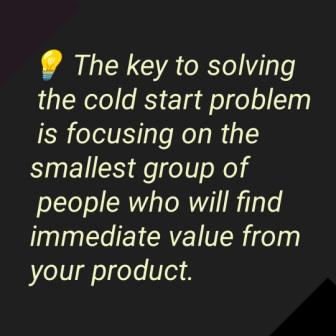
Andrew Chen’s Background and Education:
Education: Andrew Chen holds a Bachelor of Science in Applied Mathematics from the University of Washington, graduating at the age of 19.
Professional Experience:
At Uber he served as Head of Rider Growth, overseeing the expansion from 15 million to 100 million active users.
Currently a General Partner at this prominent venture capital firm, focusing on early-stage consumer technology investments.
Notable Works and Achievements:
He is an Author of a widely-followed tech and business newsletter with over 200,000 subscribers, including notable Silicon Valley founders.
Board Memberships: Serves on the boards of companies such as Clubhouse, Substack, and Sandbox VR.
Book Details:
Title: The Cold Start Problem: How to Start and Scale Network Effects
Author: Andrew Chen
Genre: Business, Entrepreneurship, Technology
Publisher: Random House Business
Publication Date: May 2021
Format: Hardcover, Ebook, Audiobook
Pages: 368
Format: E-book, Hard cover
Language: English
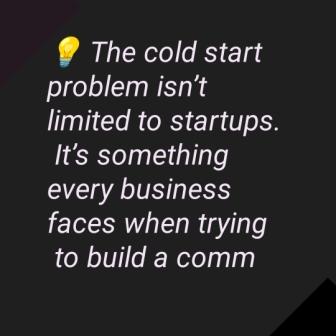
Check your Knowledge. Take short Quiz
The Cold Start Problem Quiz
-
Start The Cold Start Problem Quiz
Your Next Read
